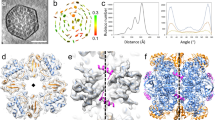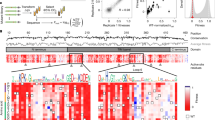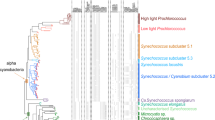Abstract
Almost all the inorganic carbon on Earth is converted into biomass via the Calvin–Benson–Bassham (CBB) cycle. Here, the central carboxylation reaction is catalyzed by ribulose-1,5-bisphosphate carboxylase/oxygenase (RubisCO), which can be found in numerous primary producers including plants, algae, cyanobacteria, and many autotrophic bacteria. Although RubisCO possesses a crucial role in global biomass production, it is not a perfect catalyst. Therefore, research interest persists on accessing the full potential of yet unexplored RubisCOs. We recently developed an activity-based screen suited to seek active recombinant RubisCOs from the environment—independent of the native host’s culturability. Here, we applied this screen to twenty pre-selected genomic fosmid clones from six cultured proteobacteria to demonstrate that a broad range of phylogenetically distinct RubisCOs can be targeted. We then screened 12,500 metagenomic fosmid clones from six distinct hydrothermal vents and identified forty active RubisCOs. Additional sequence-based screening uncovered eight further RubisCOs, which could then also be detected by a modified version of the screen. Seven were active form III RubisCOs from yet uncultured Archaea. This indicates the potential of the activity-based screen to detect RubisCO enzymes even from organisms that would not be expected to be targeted.
Similar content being viewed by others
Log in or create a free account to read this content
Gain free access to this article, as well as selected content from this journal and more on nature.com
or
References
Yokota A. Revisiting RuBisCO. Biosci Biotechnol Biochem. 2017;81:2039–49.
Erb TJ, Zarzycki J. A short history of RubisCO: the rise and fall (?) of nature’s predominant CO2 fixing enzyme. Curr Opin Biotechnol. 2018;49:100–7.
Schwander T, Schada von Borzyskowski L, Burgener S, Cortina NS, Erb TJ. A synthetic pathway for the fixation of carbon dioxide in vitro. Science. 2016;354:900–4.
Badger MR, Bek EJ. Multiple Rubisco forms in proteobacteria: their functional significance in relation to CO2 acquisition by the CBB cycle. J Exp Bot. 2008;59:1525–41.
Berg IA. Ecological aspects of the distribution of different autotrophic CO2 fixation pathways. Appl Environ Microbiol. 2011;77:1925–36.
Perner M, Seifert R, Weber S, Koschinsky A, Schmidt K, Strauss H, et al. Microbial CO2 fixation and sulfur cycling associated with low-temperature emissions at the Lilliput hydrothermal field, southern Mid-Atlantic Ridge (9°S). Environ Microbiol. 2007;9:1186–201.
Hügler M, Sievert SM. Beyond the Calvin cycle: autotrophic carbon fixation in the ocean. Annu Rev Mar Sci. 2011;3:261–89.
Nakagawa S, Takai K. Deep-sea vent chemoautotrophs: diversity, biochemistry and ecological significance. FEMS Microbiol Ecol. 2008;65:1–14.
Perner M, Kuever J, Seifert R, Pape T, Koschinsky A, Schmidt K, et al. The influence of ultramafic rocks on microbial communities at the Logatchev hydrothermal field, located 15 degrees N on the Mid-Atlantic Ridge. FEMS Microbiol Ecol. 2007;61:97–109.
Perner M, Hansen M, Seifert R, Strauss H, Koschinsky A, Petersen S. Linking geology, fluid chemistry, and microbial activity of basalt- and ultramafic-hosted deep-sea hydrothermal vent environments. Geobiology. 2013;11:340–55.
Witte B, John D, Wawrik B, Paul JH, Dayan D, Tabita FR. Functional prokaryotic RubisCO from an oceanic metagenomic library. Appl Environ Microbiol. 2010;76:2997–3003.
Böhnke S, Perner M. A function-based screen for seeking RubisCO active clones from metagenomes: novel enzymes influencing RubisCO activity. ISME J. 2014;9:735–45.
Perner M, Ilmberger N, Köhler HU, Chow J, Streit WR. Emerging fields in functional metagenomics and its industrial relevance: Overcoming limitations and redirecting the search for novel biocatalysts. In: de Bruijn FJ, editor. Handbook of molecular microbial ecology II. New Jersey: Wiley-Blackwell; 2011. p. 484–5.
Handelsman J. Metagenomics: application of genomics to uncultured microorganisms. Microbiol Mol Biol Rev. 2004;68:669–85.
Boden R, Scott KM, Williams J, Russel S, Antonen K, Rae AW, et al. An evaluation of Thiomicrospira, Hydrogenovibrio and Thioalkalimicrobium: reclassification of four species of Thiomicrospira to each Thiomicrorhabdus gen. nov and Hydrogenovibrio, and reclassification of all four species of Thioalkalimicrobium to Thiomicrospira. Int J Syst Evol Microbiol. 2017;67:1140–51.
Haase KM, Petersen S, Koschinsky A, Seifert R, Devey CW, Keir R, et al. Young volcanism and related hydrothermal activity at 5°S on the slow-spreading southern Mid-Atlantic Ridge. Geochem Geophys Geosyst. 2007;8:1–17.
Melchert B, Devey CW, German CR, Lackschewitz KS, Seifert R, Walter M, et al. First evidence for high-temperature off-axis venting of deep crustal/mantle heat: The Nibelungen hydrothermal field, southern Mid-Atlantic Ridge. Earth Planet Sci Lett. 2008;275:61–9.
Perner M, Bach W, Hentscher M, Koschinsky A, Garbe-Schönberg D, Streit WR, et al. Short-term microbial and physico-chemical variability in low-temperature hydrothermal fluids near 5°S on the Mid-Atlantic Ridge. Environ Microbiol. 2009;11:2526–41.
Perner M, Gonnella G, Hourdez S, Böhnke S, Kurtz S, Girguis P. In situ chemistry and microbial community compositions in five deep-sea hydrothermal fluid samples from Irina II in the Logatchev field. Environ Microbiol. 2013;15:1551–60.
Perner M, Hentscher M, Rychlik N, Seifert R, Strauss H, Bach W. Driving forces behind the biotope structures in two low-temperature hydrothermal venting sites on the southern Mid-Atlantic Ridge. Environ Microbiol Rep. 2011;3:727–37.
Perner M, Gonnella G, Kurtz S, LaRoche J. Handling temperature bursts reaching 464 °C: different microbial strategies in the Sisters Peak hydrothermal chimney. Appl Environ Microbiol. 2014;80:4585–98.
Böhnke S, Perner M. Unraveling RubisCO form I and form II regulation in an uncultured organism from a deep-sea hydrothermal vent via metagenomic and mutagenesis studies. Front Microbiol. 2017;8:1303.
Campbell BJ, Cary SC. Abundance of reverse tricarboxylic acid cycle genes in free-living microorganisms at deep-sea hydrothermal vents. Appl Environ Microbiol. 2004;70:6282–9.
Spiridonova EM, Berg IA, Kolganova TV, Ivanovsky RN, Kuznetsov BB, Tourova TP. An oligonucleotide primer system for amplification of the ribulose-1,5-bisphosphate carboxylase/oxygenase genes of bacteria of various taxonomic groups. Microbiology. 2004;73:316–25.
Altschul SF, Gish W, Miller W, Myers EW, Lipman DJ. Basic local alignment search tool. J Mol Biol. 1990;215:403–10.
Hyatt D, Chen GL, Locascio PF, Land ML, Larimer FW, Hauser LJ. Prodigal: prokaryotic gene recognition and translation initiation site identification. BMC Bioinformatics. 2010;11:119.
Altschul SF, Madden TL, Schaffer AA, Zhang J, Zhang Z, Miller W, et al. Gapped BLAST and PSI-BLAST: a new generation of protein database search programs. Nucleic Acids Res. 1997;25:3389–402.
van Kessel JC, Ulrich LE, Zhulin IB, Bassler BL. Analysis of activator and repressor functions reveals the requirements for transcriptional control by LuxR, the master regulator of quorum sensing in Vibrio harveyi. MBio. 2013;4:e00378–13.
Snider J, Houry WA. MoxR AAA+ATPases: a novel family of molecular chaperones? J Struct Biol. 2006;156:200–9.
Tsai YC, Lapina MC, Bhushan S, Mueller-Cajar O. Identification and characterization of multiple rubisco activases in chemoautotrophic bacteria. Nat Commun. 2015;6:8883.
Scott KM, Sievert SM, Abril FN, Ball LA, Barrett CJ, Blake RA, et al. The genome of deep-sea vent chemolithoautotroph Thiomicrospira crunogena XCL-2. PLOS Biol. 2006;4:2196–212.
Lam KN, Cheng J, Engel K, Neufeld JD, Charles TC. Current and future resources for functional metagenomics. Front Microbiol. 2015;6:1196.
Finn MW, Tabita FR. Synthesis of catalytically active form III ribulose 1,5-bisphosphate carboxylase/oxygenase in archaea. J Bacteriol. 2003;185:3049–59.
Kreel NE, Tabita FR. Substitutions at methionine 295 of Archaeoglobus fulgidus ribulose-1,5-bisphosphate carboxylase/oxygenase affect oxygen binding and CO2/O2 specificity. J Biol Chem. 2007;282:1341–51.
Alfreider A, Schirmer M, Vogt C. Diversity and expression of different forms of RubisCO genes in polluted groundwater under different redox conditions. FEMS Microbiol Ecol. 2012;79:649–60.
Trudeau DL, Edlich-Muth C, Zarzycki J, Scheffen M, Goldsmith M, Khersonsky O. et al. Design and in vitro realization of carbon-conserving photorespiration. Proc Natl Acad Sci USA. 2018;115(49):E11455–E64.
Liu D, Ramya RCS, Mueller-Cajar O. Surveying the expanding prokaryotic Rubisco multiverse. FEMS Microbiol Lett. 2017;fnx156:364. https://doi.org/10.1093/femsle/fnx156.
epicentre. Instruction Manual: CopyControl™ Fosmid Library Production Kit with pCC1FOS™ Vector. 2012;EPILIT171 Rev. A:1–27.
Rosano GL, Ceccarelli EA. Recombinant protein expression in Escherichia coli: advances and challenges. Front Microbiol. 2014;5:172.
Sivashanmugam A, Murray V, Cui C, Zhang Y, Wang J, Li Q. Practical protocols for production of very high yields of recombinant proteins using Escherichia coli. Protein Sci. 2009;18:936–48.
Kreel NE, Tabita FR. Serine 363 of a hydrophobic region of archaeal ribulose 1,5-bisphosphate carboxylase/oxygenase from Archaeoglobus fulgidus and Thermococcus kodakaraensis affects CO2/O2 substrate specificity and oxygen sensitivity. PLoS ONE. 2015;10:e0138351.
Lai Q, Li S, Xu H, Jiang L, Zhang R, Shao Z. Thioclava atlantica sp. nov., isolated from deep sea sediment of the Atlantic Ocean. Antonie Van Leeuwenhoek. 2014;106:919–25.
Sorokin DY, Tourova TP, Spiridonova EM, Rainey FA, Mulyzer G. Thioclava pacifica gen. nov., sp nov., a novel facultatively autotrophic, marine, sulfur-oxidizing bacterium from a near-shore sulfidic hydrothermal area. Int J Syst Evol Microbiol. 2005;55:1069–75.
Zhang R, Lai Q, Wang W, Li S, Shao Z. Thioclava dalianensis sp. nov., isolated from surface seawater. Int J Syst Evol Microbiol. 2013;63:2981–5.
Miller SR, McGuirl MA, Carvey D. The evolution of RuBisCO stability at the thermal limit of photoautotrophy. Mol Biol Evol. 2013;30:752–60.
Liu Y, Lai Q, Shao Z. A multilocus sequence analysis scheme for phylogeny of Thioclava bacteria and proposal of two novel species. Front Microbiol. 2017;8:1321.
Thongphrom C, Kim JH, Bora N, Kim W. Thioclava arenosa sp. nov., isolated from sea sand. Int J Syst Evolut Microbiol. 2017;67:1735–9.
Chang R, Bird L, Barr C, Osburn M, Wilbanks E, Nealson K, et al. Thioclava electrotropha sp. nov., a versatile electrode and sulfur-oxidizing bacterium from marine sediments. Int J Syst Evol Microbiol. 2018;68:1652–8.
Feller G, Gerday C. Psychrophilic enzymes: hot topics in cold adaptation. Nat Rev Microbiol. 2003;1:200–8.
Unsworth LD, van der Oost J, Koutsopoulos S. Hyperthermophilic enzymes – stability, activity and implementation strategies for high temperature applications. FEBS J. 2007;274:4044–56.
Tabita FR, Satagopan S, Hanson TE, Kreel NE, Scott SS. Distinct form I, II, III, and IV Rubisco proteins from the three kingdoms of life provide clues about Rubisco evolution and structure/function relationships. J Exp Bot. 2008;59:1515–24.
Gonnella G, Böhnke S, Indenbirken D, Garbe-Schönberg D, Seifert R, Mertens C, et al. Endemic hydrothermal vent species identified in the open ocean seed bank. Nat Microbiol. 2016;1:16086.
Hansen M, Perner M. A novel hydrogen oxidizer amidst the sulfur-oxidizing Thiomicrospira lineage. ISME J. 2015;9:696–707.
Brazelton WJ, Baross JA. Metagenomic comparison of two Thiomicrospira lineages inhabiting contrasting deep-sea hydrothermal environments. PLoS ONE. 2010;5:e13530.
Acknowledgements
We thank the captain and crews of the RV Meteor, the Maria S. Merian as well as the ROV Kiel6000 (GEOMAR, Kiel) for helping us to obtain deep-sea vent samples. We thank Wenke Bahnsen, Dagmar Svensson, Anna Ulatowski, and Nicole Adam for excellent technical assistance in the laboratory. The work was supported by grants from the Deutsche Forschungsgemeinschaft (DFG) (PE1549/5-1) and the DFG priority program 1144 “From Mantle to Ocean: Energy-, Material- and Life-cycles at Spreading Axes”.
Author information
Authors and Affiliations
Corresponding author
Ethics declarations
Conflict of interest
The authors declare that they have no conflict of interest.
Additional information
Publisher’s note: Springer Nature remains neutral with regard to jurisdictional claims in published maps and institutional affiliations.
Supplementary information
Rights and permissions
About this article
Cite this article
Böhnke, S., Perner, M. Seeking active RubisCOs from the currently uncultured microbial majority colonizing deep-sea hydrothermal vent environments. ISME J 13, 2475–2488 (2019). https://doi.org/10.1038/s41396-019-0439-3
Received:
Revised:
Accepted:
Published:
Issue date:
DOI: https://doi.org/10.1038/s41396-019-0439-3



